C++ Programming Tutorial I (a)Object-Oriented Programming Concepts |
What is an object ?
- Real-world objects:
- All have state and behavior
- Bicycles have state: current gear, two wheels, number
of gears...
- Bicycles have behavior: braking, accelerating,
changing gears...
- Software objects:
- Also have state and behavior
- Maintains its state in variables
- Implements its behavior in methods
- All have state and behavior
- Bicycles have state: current gear, two wheels, number of gears...
- Bicycles have behavior: braking, accelerating, changing gears...
- Also have state and behavior
- Maintains its state in variables
- Implements its behavior in methods
Definition: An object is a software bundle of variables and related methods.
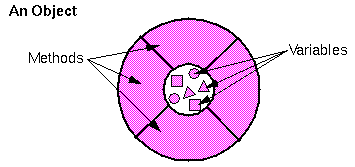
- Software objects can:
- represent real-world objects, such as a bicycle
- represent abstract concepts, such as an "Event" object in a window
system
- represent real-world objects, such as a bicycle
- represent abstract concepts, such as an "Event" object in a window system
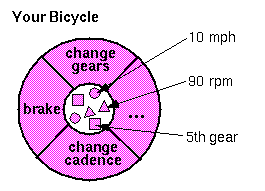
Encapsulation
- What is encapsulation?
- Anything that an object does not know or cannot do is excluded from the
object.
- Encapsulation is used to hide unimportant implementation details from
other objects.
- Implementation details of an object can be changed at any time without
affecting other parts of the program.
- Anything that an object does not know or cannot do is excluded from the object.
- Encapsulation is used to hide unimportant implementation details from other objects.
- Implementation details of an object can be changed at any time without affecting other parts of the program.
Definition: Packaging an object's variables within the protective custody of its methods is called encapsulation.
- Examples,
- When you want to change gears on your bicycle, you don't need to know
how the gear mechanism works, you just need to know which lever to move.
- With software objects, you don't need to know how a method is
implemented, you just need to know which method to invoke and its interface.
- Benefits:
-
Modularity
- Source code can be written and maintained independently
- An object can be passed easily around
-
Information hiding
- An object has a public interface for other objects to communicate
with.
- An object can maintain private information and methods that can be
changed without affecting other objects.
- Sometimes:
- For implementation or efficiency reasons, an object may wish to expose
some of its variables or hide some of its methods.
- When you want to change gears on your bicycle, you don't need to know how the gear mechanism works, you just need to know which lever to move.
- With software objects, you don't need to know how a method is implemented, you just need to know which method to invoke and its interface.
-
Modularity
- Source code can be written and maintained independently
- An object can be passed easily around
-
Information hiding
- An object has a public interface for other objects to communicate with.
- An object can maintain private information and methods that can be changed without affecting other objects.
- For implementation or efficiency reasons, an object may wish to expose some of its variables or hide some of its methods.
What are messages?
- A single object is a component of a larger program that contains many
other objects.
- Application functionality is achieved by interactions of these objects.
Software objects interact and communicate with each other by sending messages to each other.
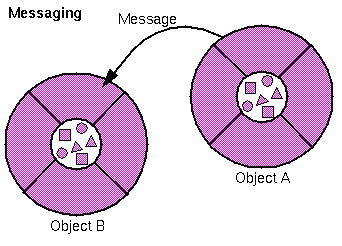

- Components of a message:
- The object to whom the message is addressed. (Your
Bicycle)
- The name of the method to perform. (changeGears)
- Any parameters needed by the method. (lower
gear)
- The object to whom the message is addressed. (Your Bicycle)
- The name of the method to perform. (changeGears)
- Any parameters needed by the method. (lower gear)
What are classes?
- Your bicycle
- Your bicycle is just one of many bicycles in the world.
- Bicycle have some state and behaviour in common.
- However, each bicycle's state is independent of and can be different
from other bicycles.
- Your bicycle object is an instance of
the class of objects known as bicycles.
- Bicycles of the same model are built using the same blueprint.
- Software objects
- Possible to have many objects of the same kind that share common
characteristics.
- Objects of the same kind can be built using the same blueprint.
- Software "blueprints" for objects are called classes.
- Your bicycle is just one of many bicycles in the world.
- Bicycle have some state and behaviour in common.
- However, each bicycle's state is independent of and can be different from other bicycles.
- Your bicycle object is an instance of the class of objects known as bicycles.
- Bicycles of the same model are built using the same blueprint.
- Possible to have many objects of the same kind that share common characteristics.
- Objects of the same kind can be built using the same blueprint.
- Software "blueprints" for objects are called classes.
Definition: A class is a blueprint or prototype that defines the variables and methods common to all objects of a certain kind.
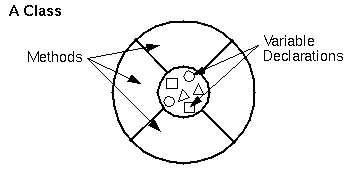
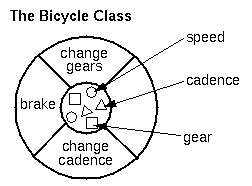
Object instantiation:
- Remember: a blueprint of a bicycle is not really a bicycle.
- When you create an instance of a class,
you create an object of that type.
- The system allocates memory for the instance variables declared by the
class.
- You can then invoke the object's instance methods to make it do something.
Classes provide the benefit of reusability.
- Programmers use the same class, and thus the same code, over and over
again to create many objects.
Polymorphism
- What is polymorphism?
- The attribute that allows one interface to be used with a general class
of actions.
- It is the compiler's job to select the specific
action as it applies to each situation.
- Example,
- Three types of stacks, one for interger values, one for strings, and one
for a specific structure.
- You can create three sets of functions called push() and pop()
, one for each type of data.
- The general interface is that of pushing and popping data onto and from
a stack.
- When you push data on or pop from the stack, it is the type of the data
that will determine which specific version of push() or pop()
, that will be called.
- The attribute that allows one interface to be used with a general class of actions.
- It is the compiler's job to select the specific action as it applies to each situation.
- Three types of stacks, one for interger values, one for strings, and one for a specific structure.
- You can create three sets of functions called push() and pop() , one for each type of data.
- The general interface is that of pushing and popping data onto and from a stack.
- When you push data on or pop from the stack, it is the type of the data that will determine which specific version of push() or pop() , that will be called.
Polymorphism helps reduce complexity by allowing the same interface to be used to specify a general class of actions.
What is inheritance?
- The process by which one object can acquire the properties of another
object.
- Concept of classification
- Red Delicious apple ---> apple ---> fruit --->
food
- An object (class) need only define those qualities that make it unique.
- Allow classes to be defined in terms of other classes.
- Mountain bikes, racing bikes, and tandems are all different kinds of
bicycles.
- These are subclasses of the bicycle class.
- The bicycle class is the superclass of
these subclasses.
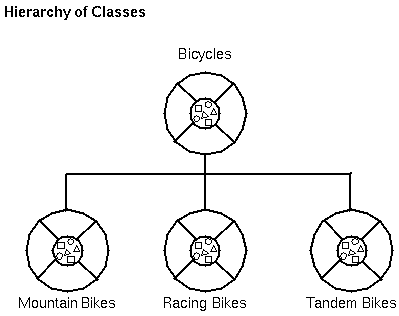
- Each subclass inherits instance variables from the superclass.
- Each subclass inherits methods from the superclass.
- Subclasses can add their own variables and
methods.
- Subclasses can override inherited methods.
The class hierarchy can be as deep as needed.
- Methods and variables are inherited down through the levels.
- The further down in the hierarchy a class appears, the more specialized
its behavior.

